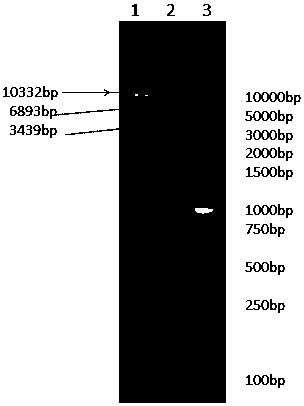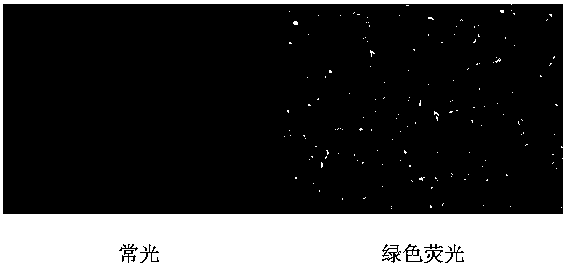A kind of chicken mda5 gene promoter and application thereof
A promoter and promoter sequence technology, applied in the field of genetic engineering, can solve the problems of unclear regulatory mechanism of MDA5 and unreported research, and achieve the effect of convenient verification, prediction and screening
- Summary
- Abstract
- Description
- Claims
- Application Information
AI Technical Summary
Problems solved by technology
Method used
Image
Examples
Embodiment 1
[0030] Embodiment 1: chicken melanoma differentiation-associated gene 5 (MDA5) promoter fragment and corresponding acquisition
[0031] NCBI database (http: / / www.ncbi.nlm.nih.gov) searched the upstream regulatory sequence of chicken melanoma differentiation-related gene MDA5, predicted the approximate region of MDA5 promoter, and used this sequence as the research object. Design primers (the primer sequence is shown in Table 1), and use the white chicken genomic DNA as a template to amplify the promoter region of MDA5 by PCR. The amplified products are identified by 1% agarose gel electrophoresis and purified and recovered with Tiangen recovery kit , the fragment was connected to the pMD19-T (Takara) vector, and sent to the handsome company for sequencing. The obtained promoter sequence is shown in SEQ ID NO:3.
[0032] Primer name
Embodiment 2
[0033] Example 2: Construction of chicken melanoma differentiation-associated gene 5 (MDA5) promoter transfection vector
[0034] Using the MDA5 promoter connected to the pMD19-T vector as a template, primers were designed for PCR amplification, and two Dicer sites, PciⅠ and BamHI, were introduced. The sequences of the primers are shown in Table 2. The amplified product was identified by 1% agarose gel electrophoresis and purified and recovered with the Tiangen recovery kit, then connected to the pEASY-T1 vector with the full-type gold pEASY-T1 Cloning Kit kit, and sent to Yingjun Company sequencing. After sequence comparison, select the samples with correct sequencing for future use.
[0035] Table 2 Amplification primers introducing PciⅠ and BamHI restriction sites
[0036]
[0037] Use restriction endonucleases PciⅠ and BamHI (both purchased from NEB Company) to double-digest the vector pDsRed1-N1 plasmid (Clontech) and the promoter fragment connected to pEASY-T1 respe...
Embodiment 3
[0058] Example 3: Cell Transfection of Recombinant Plasmids
[0059] In this study, chicken embryonic fibroblasts (DF-1) were adherent cells, which were cultured by adherent cell culture method. The cells are passaged in culture dishes or well plates, cultured in a 37°C incubator with a carbon dioxide concentration of 5%, and the growth status of the cells, such as cell shape and density, is observed through a microscope. Under normal circumstances, subculture once every three days. The cell culture medium is DMEM high-glucose medium containing 10% fetal bovine serum and 0.01% penicillin-streptomycin solution.
[0060] Prior to cell transfection, transfer the cells into a 24-well plate to reach a density of 70-80% within 24 hours. Cell transfection was carried out by liposome method at about 24 hours. The liposome used was Lipofectamine® LTX & PLUS Reagent (Invitrogen), and the specific operation was carried out strictly according to the instructions.
[0061] About 36 hou...
PUM
 Login to View More
Login to View More Abstract
Description
Claims
Application Information
 Login to View More
Login to View More - R&D
- Intellectual Property
- Life Sciences
- Materials
- Tech Scout
- Unparalleled Data Quality
- Higher Quality Content
- 60% Fewer Hallucinations
Browse by: Latest US Patents, China's latest patents, Technical Efficacy Thesaurus, Application Domain, Technology Topic, Popular Technical Reports.
© 2025 PatSnap. All rights reserved.Legal|Privacy policy|Modern Slavery Act Transparency Statement|Sitemap|About US| Contact US: help@patsnap.com



